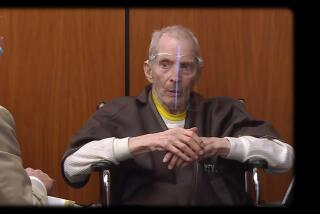Movie review: âAll Good Thingsâ
âAll Good Things,â a twisted mystery starring Kirsten Dunst and Ryan Gosling, is a stretch. A better name might have been âA Few Good Thingsâ or âHow a rich kid became a cross-dressing murdering mute and got away with it.â The murders, that is. The cross-dressing bit he didnât even try to cover up.
But back to the good thing about âAll Good Thingsâ â that would be Kirsten Dunst, for if there is one thing this strange and creepy film does well it is remind us of just what a talented actress she is. Gosling is good too, but Dunst is âall good,â beautifully nuanced as a young woman whose hopeful dreams turn dark and deadly.
Though the film is a fiction, it is based on the real story of Robert and Kathie Durst. He was the son of a New York real estate magnate; she was a Long Island girl trying to make it in the big city when they met. Love and marriage soon followed. But the other half of the phrase that begins with âall good thingsâ is âmust come to an end,â and so they did â badly.
Ten years in, the marriage apparently turned violent and one day Kathie vanished into thin air. No body was found; no murder charges were filed. Over the years the case would occasionally be pulled out and dusted off, most notably in 2000. It still wasnât solved, but two people close to Robert were killed around the same time â a longtime female friend (played by Lily Rabe), and one of his neighbors in the Galveston, Texas, rooming house where he was living.
The question that has been hanging in the air since Kathie disappeared is: What really happened? That is what the film sets out to answer. Itâs exactly the kind of conundrum that appeals to director Andrew Jarecki. Best known for his explosive documentary âCapturing the Friedmans,â (about a family imploding over pedophilia allegations) and for producing this yearâs âCatfishâ (a controversial doc about people creating false identities online), Jarecki has found his wheelhouse where real life and the bizarre intersect.
His fine documentary sensibility, though, is the filmâs downfall. The names have been changed â the couple is now called Katie and David Marks â but little else has. Instead, âAll Good Thingsâ is a case of letting the facts get in the way. If the filmmakers had been bolder with their theories, the movie itself would likely have been much better given the general quality of the performances and the artistry of cinematographer Michael Seresin (though the film might have benefited from a bit more of the black mood he brought to âMidnight Expressâ and âHarry Potter and the Prisoner of Azkabanâ).
The facts were certainly a juicy starting point. Jarecki and screenwriters Marc Smerling and Marcus Hinchey spent years culling through police files, newspaper articles and transcripts of the one murder Durst was tried for: that of his neighbor (renamed Malvern here and played by Philip Baker Hall), whose dismembered body was found in Galveston Bay. Durst was cleared of the murder charge, but did a few years for evidence tampering and other minor offenses. Most of the specifics are laid out as the film follows some 30 years of Davidâs life.
Gosling and Dunst are at their best as a young couple in love. Though you feel the long arm of the family and its steel-fisted patriarch played with a cold efficiency by Frank Langella, the actress infuses Katie with a free-spirited innocence and openness that is so winning you understand why David fell in love, and dad accepted their marriage. Dunst literally lights up the screen. Meanwhile, Gosling wears the rebellious rich boy role like the custom-made tux he dons for their first date. There is a great playfulness the actors create as a hopeful pair defying dad and setting up housekeeping in Vermont, where they run an organic food store (does Vermont have any other kind?).
But the film gets badly off track when the good things start to end. There is the overbearing father for David to contend with, and heâs still haunted by his motherâs suicide he witnessed as a child, but still â multiple murders, cross-dressing disguises? Gosling is given the barest blueprint of a life gone terribly wrong and the actor struggles to make something out of nothing, though he does manage to give the older David an aura of weirdness that is downright creepy.
There is a point during the murder trial when David is asked why he started wearing dresses, heels and a bad blond wig. Basically he says, âit was the easiest way to stop being David Marks.â Which is a reason, not an explanation. And that is how âAll Good Thingsâ ultimately fails us. The facts pile up, but the demons that would lead to such dark deeds remain out of sight. Did he or didnât he? Maybe, probably, who knows for sure? Certainly not us.
More to Read
Only good movies
Get the Indie Focus newsletter, Mark Olsen's weekly guide to the world of cinema.
You may occasionally receive promotional content from the Los Angeles Times.











